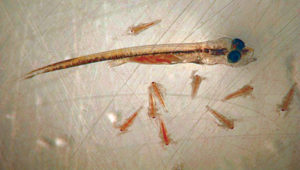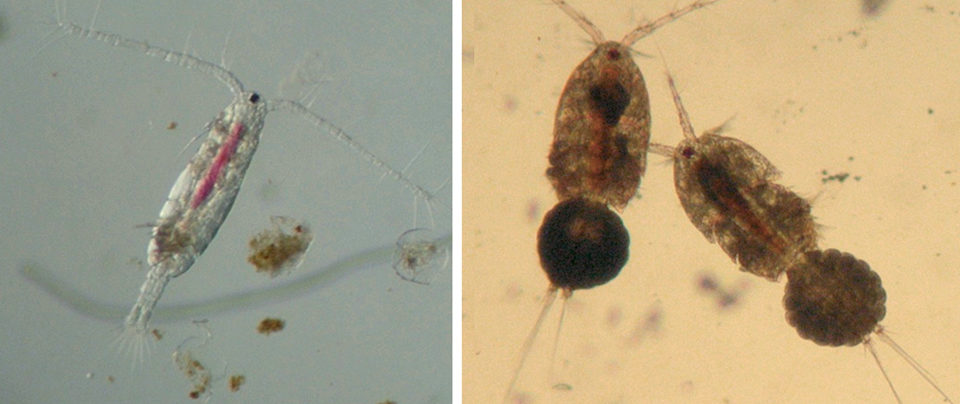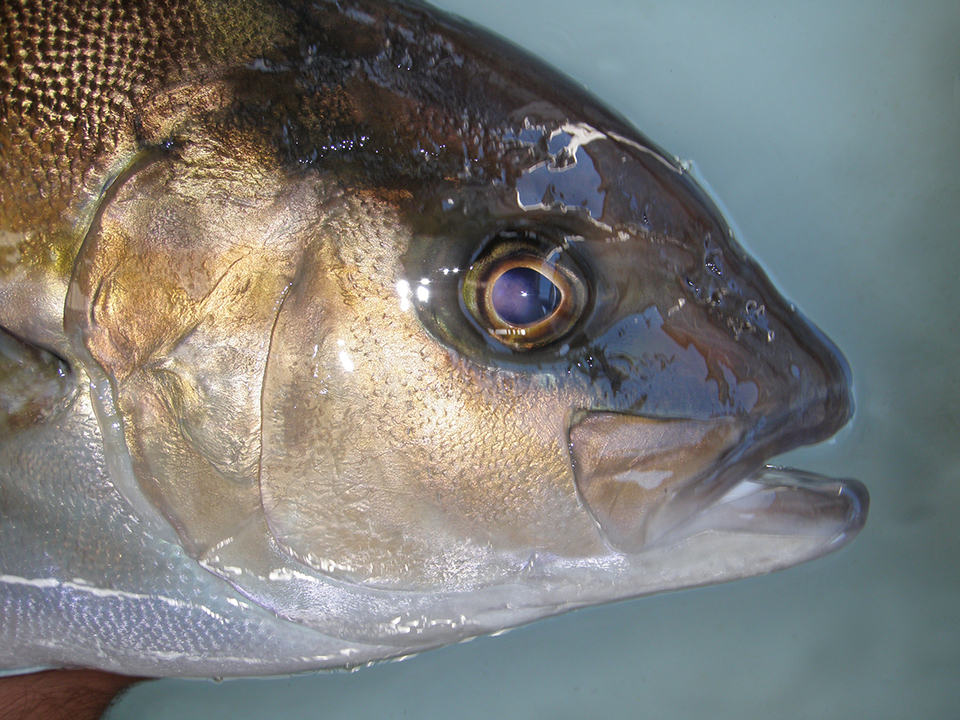Copepods offer superior nutritional value, but rearing is laborious

Most significant animal groups produced in marine aquaculture – mollusks, shrimp and fish – have larval stages of small dimensions that need to be fed live plankton during the first periods of their lives. The larval period is considered crucial, as starvation and/or predation are unfavorable to successful recruitment into juveniles and adults. This period varies among groups and even species within the same group.
Larval challenges
The first stages of bass, bream, meager, sole and many other marine fish have small larvae with very limited yolk reserves at hatching that are consumed in two or three days at 20 degrees-C. They have small mouths that restrict the size of the food particles that can be ingested. In shrimp, the size of the larval food is also a problem, but it is not as restrictive because shrimp have appendices that help catch and break food.
Some cultured groups like penaeid shrimp undergo larval stages that change from herbivorous, filter-feeding creatures that eat microalgae to carnivorous animals that feed on artemia species. Mollusk bivalves like oysters, clams, mussels and the gastropod-like abalone are filtering organisms that feed on microalgae during their entire life cycles.
Wild diets
In the wild, the diets of these marine fish larvae, crustacean larvae and mollusks consist of a wide diversity of phytoplankton species with different sizes and biochemical compositions (diatoms, flagellates and green algae), and zooplankton organisms like copepods and small larvae from crustacean and other groups.
The varied sizes and compositions of the plankton are important for meeting all the nutritional requirements of these larvae, but collecting natural plankton for use as aquaculture feed isn’t viable in industrial production.
Cultured diets
In marine larviculture, three groups of live diets are widely applied (Table 1), selected according to a number of criteria that reflect compromises among practicality for the culturist and the behaviors, sizes and nutritional values of the different cultured species. On one hand, diets must be available, cost-effective, simple to use and versatile in their application. On the other, they must have good nutritional value and be easily captured and digested by the larvae.
Pousão-Ferreira, Groups of plankton, Table 1
| Live Feed | Dimension | Target Species |
|---|---|---|
| Microalgae | 2-20 µ | Bivalves, shrimp, rotifers, copepods, Artemia |
| Rotifers | 50-220 µ | Shrimp, marine fish |
| Artemia | 400-800 µ | Mollusks, shrimp, marine fish |
The visual range over which zooplankton can be detected by most fish larvae is very important, particularly at early feeding. Zooplankton organisms are motile, which facilitates their detection by the feeding larvae. The density of plankton in the water column is also important, since the presence of numerous individuals increases the frequency of encounters with the larvae, which in most cases have low mobility. Air supply and water influx in larval-rearing tanks need to be considered, as well, since they contribute to better distribution of plankton in the water column.
In recent years, varied supplementation and substitution products have been developed to improve the nutritional quality of live feeds and promote earlier transition to inert feeds.
Microalgae
The nutritional composition of specific microalgae can vary considerably according to the culture conditions and growth phase/age of the culture. Since particular microalgae can lack nutrients that are present in others, a mixture of algal species is often used to supply adequate amounts of nutrients. Mollusk culture, for example, normally uses several microalgae, and crustacean and fish larvae are often fed a mix of two.
The alternative to on-site algal culture is the use of preserved microalgae. Specialized companies sell concentrated pastes of specific microalgae, frozen microalgae concentrates, dried specific or mixed microalgae, and dried extracts of microalgae and other substances for greenwater culture. Another method is the preparation of microalgal concentrates based on chemical flocculation.
Heterotrophic growth conditions that utilize organic carbon instead of light as an energy source have been developed for the large-scale production of microalgae. Although they are not yet widely implemented, they can have an important role in producing future alternative sources of essential polyunsaturated fatty acids arachidonic acid, eicosapentaenoic acid (EPA) and docosahexaenoic acid (DHA).

Rotifers
The brackishwater rotifer (Brachionus plicatilis) was identified by Japanese aquaculturists as a suitable starter diet in marine fish larviculture in the 1960s. Under optimal culture conditions, B. plicatilis has high fecundity and reproduces by parthenogenesis – asexual reproduction in which each female produces several eggs at a time. After hatching, the rotifers reach reproductive stage in only a few days.
Hatcheries have used rotifer body size to distinguish their marine Brachionus cultures in large, medium, small or super small categories for use alone or mixed, but this classification is somewhat inaccurate. Nowadays there are divisions within each size group for different species and biotypes with somewhat different optimal culture conditions.
Different species or biotypes can grow well in one hatchery and fail in another. So it is advisable to regularly renew rotifer stocks from specialized labs or enterprises that maintain purified production. Also, resting eggs can be used for setting up cultures or when production collapses.
Brine shrimp
Brine shrimp, artemia nauplii, are the most widely used species of live food applied in the larval rearing of fish and crustaceans. Artemia cysts are easy to keep in the dormant stage, and after 24 hours of immersion in saltwater at 26 to 28 degrees-C, the embryos hatch and release 0.4 to 0.5 mm instar I nauplii that swim in the water. These nauplii are used immediately, before they grow too large to fit the mouths of larval fish and their nutritional value decreases.
One of the biggest disadvantages of artemia is their deficiency in essential fatty acids for marine fish larvae. Depending on the species and strain, they have low levels of EPA and no DHA, and their fatty acid profiles can only be modified when the nauplii have functional digestive systems.
Another constraint with the use of live foods that rapidly lose nutritional value is that fish and crustacean larvae need to be fed several times a day to ensure sufficient prey quantity and quality. This is laborious and time-consuming. To prevent enrichment loss in artemia and rotifers, and keep artemia from growing, they should be kept in a refrigerator at 6 ± 1 degrees-C and distributed to culture tanks when necessary.
Copepods
Copepods are also used as live feeds for marine fish larvae. They have a much higher content of EPA and DHA, and greater nutritional value than rotifers and artemia. Amino acid concentrations are also generally higher in copepods. The main copepod groups used in aquaculture are Calanoids, mainly Acartia species, and Harpacticoids like Tisbe species.
Besides their superior nutritional value, copepods have a wide range of body sizes within and among species. The early nauplii and copepodites can be extremely useful as initial prey for species with small mouths at first feeding. However, copepod rearing requires space and is very laborious.
Their density in culture is usually very low when compared with rotifers and artemia, which is a constraint for industrial production. Due to the relative ease and low cost of culturing rotifers and artemia in high densities, it is unlikely copepod culture will replace them as an economically viable alternative in the near future.
In aquaculture, copepods are mostly used in semi-intensive larval-rearing systems for a short initial period during the larval stage to ensure normal development. They can be cultured in large quantities in outdoor mesocosms, collected in the wild or reared in indoor tanks to obtain resting eggs that will later be hatched for nauplii according to fish larval requirements.

Protozoa
Ciliates and other protozoa play an important role for first-feeding fish larvae in the wild. In mesocosm experiments, they seem to enhance survival by bridging the gap until larvae encounter copepod nauplii. Although not commonly used as live feed for fish larvae, the heterotrophic dinoflagellate Oxyrrhis marina can be a potential candidate during the first feeding stages.
In aquaculture, O. marina are often fed to copepods, since they increase female fecundity. Compared to more common live feeds for fish larva O. marina is a much smaller organism whose morphological characteristics change easily at different development stages. Their lengths vary from about 8 to 24 μ, while widths range from 6 to 20 μ.
Their value as fish larvae feed has still to be proven, but protozoa are extremely easy to culture and manipulate, offering good potential for rearing marine fish larvae with small mouth gapes.
(Editor’s Note: This article was originally published in the May/June 2012 print edition of the Global Aquaculture Advocate.)
Authors
-
Pedro Pousão-Ferreira
Instituto Nacional de Recursos Biológicos, I.P.
Instituto de Investigação das Pescas e do Mar
Av. 5 de Outubro s/n
8700-305 Olhão, Portugal[116,112,46,114,97,109,105,112,105,64,111,97,115,117,111,112,112]
-
Ana Candeias Mendes
Instituto Nacional de Recursos Biológicos, I.P.
Instituto de Investigação das Pescas e do Mar
Av. 5 de Outubro s/n
8700-305 Olhão, Portugal -
Sara Castanho
Instituto Nacional de Recursos Biológicos, I.P.
Instituto de Investigação das Pescas e do Mar
Av. 5 de Outubro s/n
8700-305 Olhão, Portugal -
Emília Cunha
Instituto Nacional de Recursos Biológicos, I.P.
Instituto de Investigação das Pescas e do Mar
Av. 5 de Outubro s/n
8700-305 Olhão, Portugal
Tagged With
Related Posts

Health & Welfare
Advances in yellowtail larval rearing
The University of the Canary Islands in Spain is researching yellowtail broodstock management and larval rearing to promote aquaculture diversification in Europe.

Health & Welfare
A comprehensive look at the Proficiency Test for farmed shrimp
The University of Arizona Aquaculture Pathology Laboratory has carried out the Proficiency Test (PT) since 2005, with 300-plus diagnostic laboratories participating while improving their capabilities in the diagnosis of several shrimp pathogens.

Aquafeeds
A look at phospholipids in aquafeeds
Phospholipids are the major constituents of cell membranes and are vital to the normal function of every cell and organ. The inclusion of phospholipids in aquafeeds ensures increased growth, better survival and stress resistance, and prevention of skeletal deformities of larval and juvenile stages of fish and shellfish species.

Health & Welfare
A study of Zoea-2 Syndrome in hatcheries in India, part 1
Indian shrimp hatcheries have experienced larval mortality in the zoea-2 stage, with molt deterioration and resulting in heavy mortality. Authors investigated the problem holistically.


